
Hands on Review: ITW Gov Reg – Inline Secondary Regulator by ITW Pressure Regulator Technologies
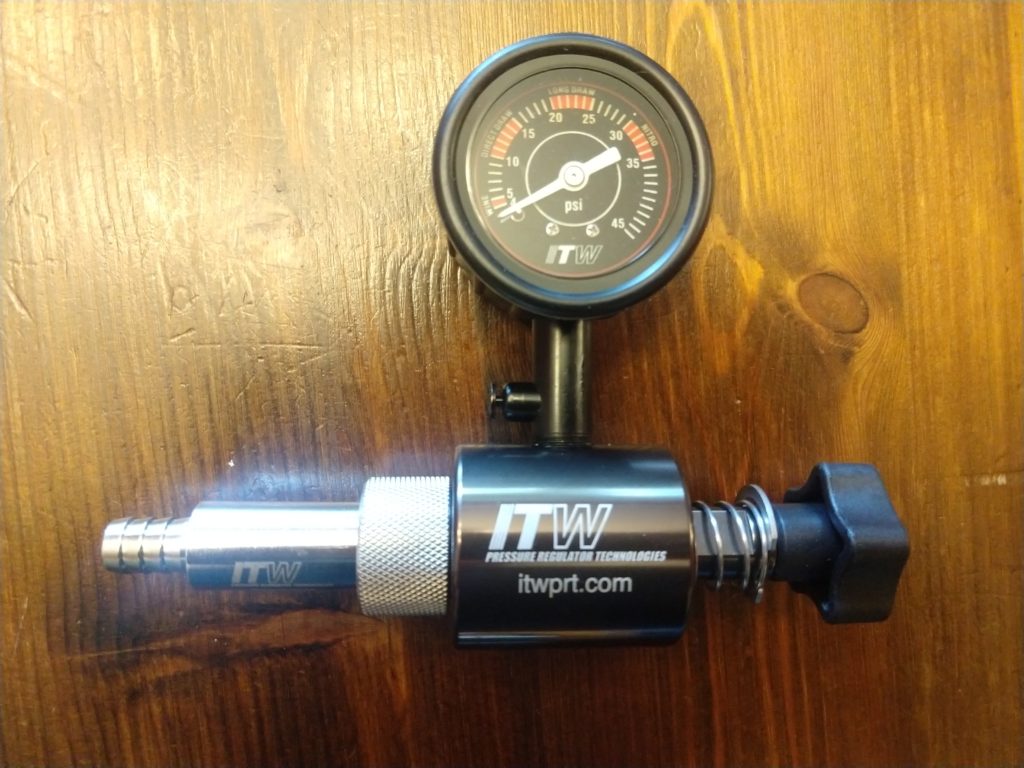
Updated: February 26, 2025
This review is by Homebrew Finds Contributor Brad Probert. Brad is an engineer, expert homebrewer and experienced reviewer. Grab a link to Brad’s website at the end of this review.
Keezers are one of the cool inventions homebrewers brought to the world of household appliances. Homemade kegerators and freezers converted to storing and dispensing homebrew allow homebrewers to exercise their creative muscle. Breaking down the function of the homebrew keezer, there are three main categories: 1) Providing CO2 to the beer, 2) Keeping the beer cold, and 3) Serving the beer. For sure, the category of serving the beer is where all the bling comes in, with different style taps and fancy tap handles. But this review is about some gear for the less flashy side- providing CO2 to the beer.
Related… Kegland Inline Secondary!
Kegland’s inline secondary is a flexible, reasonably priced option. Digital gauges are also available. This may be a better option than the ITW.
Kegland Inline Secondary with Gauge
- Duotight In-Line Regulator | Built-In Pressure Gauge | 0-60 PSI | Liquid & Gas Compatible | 8 mm Duotight D1047 – via MoreBeer
- Duotight In-Line Regulator | Built-In Pressure Gauge | 0-150 PSI | Liquid & Gas Compatible | 6.35 mm Duotight D1093 – via MoreBeer
- Duotight Regulator with 60 PSI Gauge – via William’s Brewing
- Amazon – Search DuoTight Inline Regulator to shop around
- HKNNSDEED Home Brewing Push , Regulator Wine Accessories, for Water Or Gas – 8mm (5/16″ Push in) Home Brew – affiliate link, note that multiple variations of this product may be available, as such a different version may appear at this link – Note that this appears to being the Kegland Inline Secondary by looking at the picture
Inline Secondary CO2 Regulator (no gauge)
Duotight In-Line Regulator | 0-150 PSI | Liquid & Gas Compatible | 8 mm Duotight D1046
This article contains affiliate links. We may make a small percentage if you use our links to make a purchase. You won’t pay more and you’ll be supporting Homebrew Finds and more content like this. Thank you for your support!
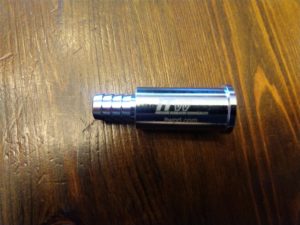 Regulator Body
Regulator Body
ITW Pressure Regulator Technologies is a business focused on pressure regulation in the medical and beverage fields. They focus on unique devices within this space. The Gov Reg is a pressure regulator designed for the commercial bar industry that can be used in the homebrew world. It’s a replacement for your secondary regulator that you’d typically have mounted inside your keezer to adjust supply pressure down to serving pressure. Typical secondary regulators will have their own adjustment knob and a dial gauge to read the output pressure you adjust to. The ITW Gov Reg serves this function, but it breaks it into two parts. The first is the regulator body itself that regulates the pressure down, the other is a stand-alone tool that is used to adjust and measure the pressure. So you set the main body to the desired pressure with the tool while monitoring the gauge, then take the tool off and install the regulator into your CO2 system.
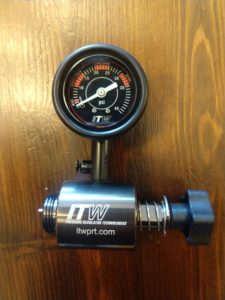 Pressure Adjustment Tool
Pressure Adjustment Tool
GovReg vs Kegland Inline?
What’s the difference between this and Kegland’s Inline Secondary? The GovReg costs quite a bit more than the Kegland Inline Secondary and requires a special tool to set pressures.
There are pros and cons to this kind of 2-piece arrangement. The con is you can’t adjust your pressure on a CO2 line conveniently. You have to shut off the gas supply, unscrew the Gov Reg and screw on the gauge tool, and then adjust. However, you probably know how often you adjust your regulators to know if that’s a real inconvenience or not. At a commercial/bar level, controlling the access to gas pressure adjustment is an obvious advantage. The ITW Gov Reg is stainless steel- meaning it’s easy to clean, can be boiled to sanitize, and connections can be pressure checked under water (which is a robust way to test for leaks). It also means the regulator is super-durable and not prone to breakage as you’re shuffling kegs around inside your keezer.
In addition to the streamlined, durable package, the other benefit the Gov Reg design has is pressure accuracy. Its unique design with large machined threads, check ball, and dual reaction springs give it this advantage. The typical diaphragm regulator with its adjustment knob and gauge is only accurate to +/- 2 psi. The ITW Gov Reg is much more accurate, within +/- 0.5 psi. That’s a big difference if you’re trying to dial in a specific pressure to be true to style for a particular beer.
Hands on Review
 Ball Lock Adapter with Regulator- Assembled
Ball Lock Adapter with Regulator- Assembled
On opening the package, the shiny silver finish made the Gov Reg look impressive. Picking them up, the heft of them combined with the high quality surface helped back up the look to make an overall impressive package. The base Gov Reg comes with a tightening nut to screw onto the standard Sankey coupler used on commercial kegs. ITW also has a ball lock adapter available that screws on and provides a ¼” FFL attachment point to screw directly onto a threaded corny keg disconnect. This adapter was easily screwed on by hand to the Gov Reg with a knurled tightening ring with a compressible gasket inside that kept it airtight.
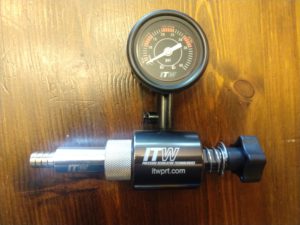 Pressure Adjustment Tool Attached to Regulator
Pressure Adjustment Tool Attached to Regulator
Next, I set the Gov Reg body to my desired pressure. For this, I hand-screwed the Gov Reg body and gasket to the adjusting tool and then connected the Gov Reg to my CO2 line. But when applying pressure, the gauge didn’t move for me. After some investigation, I found if I pulled back the rubber protective ring on the gauge, there was a small plug on top of the gauge. Pulling the plug out, a burp of oil came out. Putting it all back together, the gauge was now working. Talking with ITW about this, they noted they had seen issues were the dampening oil put into the gauge was sometimes being overfilled, and that resulted in the symptoms I saw. They had since made adjustments in their production. With the excess oil out, the gauge needle was moving and I could easily set the regulator pressure.
My initial approach was to put one Gov Reg on each of the 4 tapped kegs in my keezer and be able to set each to a different pressure. The length of the Gov Reg + ball lock adapter sticks up higher off the keg than a simple threaded connection. Measuring off the top of the keg handles, the standard fitting at its highest was 1” above the handle, and the ITW Gov Reg was 2”. This worked for me because I had plenty of headroom above my kegs in my keezer. The Gov Reg has a barbed fitting for a 5/16” ID hose on the opposite end. Depending on your gas line size, this might be a larger size than what you have and require the appropriate attachments on your gas distribution manifold.
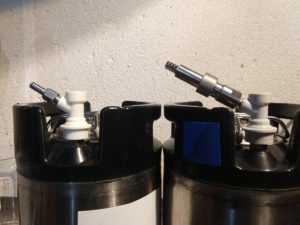 Height Comparison between Gov Reg and Standard Fitting
Height Comparison between Gov Reg and Standard Fitting
I then re-thought the features of the Gov Reg and how to maximize them in a homebrew keezer. Although I could replace the multiple adjustment knobs/gauges with multiple ITW Gov Regs, I stopped and thought about how often I run a different pressure in my keezer. Although I liked the idea of having a high pressure tap for bust carbonation and a lower pressure tap for normal serving, I rarely did burst carbonating. I would either forget it and over-carbonate the beer, or not do it long enough and it would seemingly have no effect. So in reality, I only needed a single regulator set at serving pressure and that would serve my purposes.
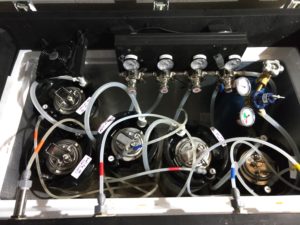 Previous Keezer Design with Large Space Occupied by Gauges and Adjustment Knobs
Previous Keezer Design with Large Space Occupied by Gauges and Adjustment Knobs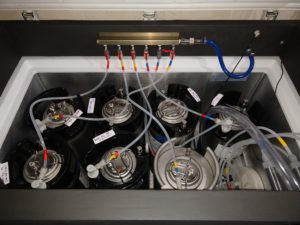 New Keezer Layout Fitting 6.5 Kegs
New Keezer Layout Fitting 6.5 Kegs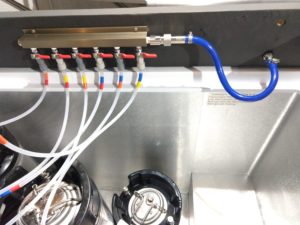 6-Way Manifold Plus ITW Gov Reg Very Space Efficient
6-Way Manifold Plus ITW Gov Reg Very Space Efficient
With this new vision of how to capitalize on the Gov Reg design, I set about on minimization. My previous keezer had a 4-way manifold with 4 separate adjustment knobs and gauges. That manifold took up so much space inside the keezer, that it would get in the way of kegs and their beer/gas lines and I struggled to fit 4 kegs inside. With the ITW Gov Reg, I could simplify the secondary pressure regulator in a much more package-efficient design and then just use a simple multi-valve gas distribution manifold. With the extra space freed up inside the keezer, I was able to fit 6 kegs inside easily (plus a 2.5 gallon one on the compressor hump) and be able to put them in and take them out without getting hung up on a bank full of giant gauges and valves.
Conclusions
The ITW Gov Reg might not be the right fit for everyone. But it does bring a few things to the table that are unique. Its stainless steel construction offers durability, and its gauge-less design frees up precious space inside your keezer. And if you’re trying to target an exact carbonation level referenced in some brewing books, the unparalleled pressure accuracy can’t be beat. For me, I’m ecstatic to have the space back inside my keezer to easily fit 6.5 kegs now!
Related… Kegland Inline Secondary!
Kegland’s inline secondary is a flexible, reasonably priced option. Digital gauges are also available. This may be a better option than the ITW.
Kegland Inline Secondary with Gauge
- Duotight In-Line Regulator | Built-In Pressure Gauge | 0-60 PSI | Liquid & Gas Compatible | 8 mm Duotight D1047 – via MoreBeer
- Duotight In-Line Regulator | Built-In Pressure Gauge | 0-150 PSI | Liquid & Gas Compatible | 6.35 mm Duotight D1093 – via MoreBeer
- Duotight Regulator with 60 PSI Gauge – via William’s Brewing
- Amazon – Search DuoTight Inline Regulator to shop around
- HKNNSDEED Home Brewing Push , Regulator Wine Accessories, for Water Or Gas – 8mm (5/16″ Push in) Home Brew – affiliate link, note that multiple variations of this product may be available, as such a different version may appear at this link – Note that this appears to being the Kegland Inline Secondary by looking at the picture
Inline Secondary CO2 Regulator (no gauge)
Duotight In-Line Regulator | 0-150 PSI | Liquid & Gas Compatible | 8 mm Duotight D1046
Check Current Pricing, Selection and Availability:
- Gov Reg In line Secondary at Keg Connection
- Gov Reg Adjusting Tool at Keg Connection
Related: DuoTight Inline Secondary
Also Consider, DuoTights & EVABarrier
duotightreviewMore Photos
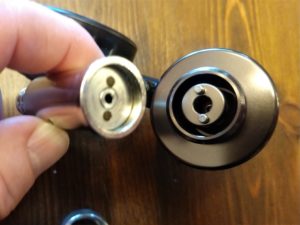 Adjustment Holes in Regulator Align with Pins in Adjusting Tool
Adjustment Holes in Regulator Align with Pins in Adjusting Tool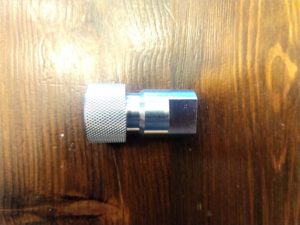 Ball Lock Adapter
Ball Lock Adapter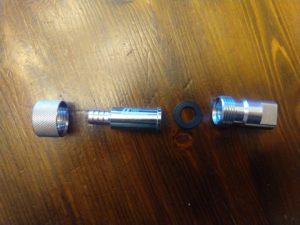 Ball Lock Adapter with Regulator- Disassembled
Ball Lock Adapter with Regulator- Disassembled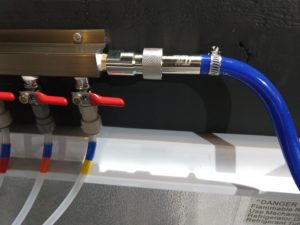 ITW Gov Reg Attached to Gas Distribution Manifold
ITW Gov Reg Attached to Gas Distribution Manifold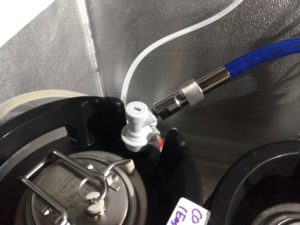 ITW Gov Reg Attached to Individual Gas Disconnect
ITW Gov Reg Attached to Individual Gas Disconnect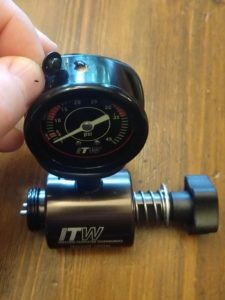 Plug to Relieve Excess Gauge Damping Oil
Plug to Relieve Excess Gauge Damping Oil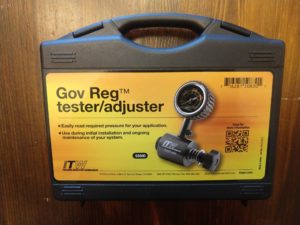 Pressure Adjustment Tool Storage Case
Pressure Adjustment Tool Storage Case
More Homebrew Finds!
- Last 50 Finds!
- Top Deals – a curated list of the best deals
- Homebrew Reviews – one of the largest libraries of homebrew reviews in existence!
- Our Top Posts – tips, how-tos, resources posts and more
- Let’s be Friends!
Recent Deals!
10 Most Recent Homebrew Resource Posts & How-To’s!
We are Homebrew Review HQ! Our 10 Most Recent Reviews
By Brad Probert. Check out Brad’s website – beersnobby.com
Special Thanks to ITW Pressure Regulator Technologies for providing the unit used for evaluation in this review.
Also: Kegerator Tips & Gear | Keg Repair Part #s | Recent Keg Finds
Our Top Draft Resources!
Check our our Top Draft Related Resources- Commentary: Pin Lock Keg Pricing and Availability
- Check Your CO2 Regulator for Leaks!
- How to get a keg ready for first use? New Keg Cleaning and Prep
- Portable Draft Beer Serving Options!
- Pin Lock Keg Pricing and Availability
- The Most Difficult Spot to Check for CO2 Leaks
- Keg O-Ring Materials Selection! – EPDM, Silicone and Buna-N?
- Why Do I Have Bubbles in My Beer Line? Diagnosing and Fixing Kegerator Foam Problems
- Five Benefits of Using Corny Kegs As Fermenters
- Rebuilding & Reconditioning Homebrew Kegs!
- Food Safe Replacement Keg O-Rings in Bulk
- Hands on Review: Kegland DuoTight Fittings & EVABarrier Tubing!
- Why Won’t My Beer Carbonate? Fixing Draft Beer Carbonation Problems
- What Does a Flow Control Faucet Do?
- Upgrade Your Kegerator – 6 Improvements!
- Serve Homebrew on Any Kegerator & Convert Commercial Kegerator to Homebrew
- Tips and Gear for Growler Filling
- What’s the Difference Between Ball Lock Kegs and Pin Lock Kegs?
- Checking for Draft System CO2 Leaks – Using The Pressure Gauge Method
- Tip: Consider Oetiker Stepless Clamps for Kegerator Gas and Beer Lines
- Hands On Review: Inkbird ITC-308 Dual Stage Temperature Controller +WiFi Version
- Universal Poppets Tips and Tricks!
- Convert Your Mark II Keg & Carboy Washer to a Recirculating Draft Line Cleaning Pump!
- Step by Step: Finding and Fixing Keg CO2 Leaks
- Kegerator Temperature Probe Placement – To Immerse or Not To Immerse? – three tests to determine optimal pla…
- Kegerator Beer Line Temperatures & Reducing Foam with a Recirculating Fan
- Kegging CO2 Use Estimations and Calculations
- Balancing Your Kegerator Draft System
- Building a Simple Ball Lock Draft Line Flushing Setup
- Build a Recirculating Draft Line Cleaning Pump
- Home Brew Keg Roundup – New & Used, 5 and 2.5 Gallon & More!
- Damp Kegerator? Fix Kegerator Condensation
- Homebrew Temp Controller Roundup! – Kegerator and Fermentation – concepts, applications and models
- Bulk Keg Orings and Keg Parts Reference
This post may contain affiliate links. We may make a commission when you use our links. This will never cost you extra. Thank you for supporting Homebrew Finds!
greatdealsPrice, promotions and availability can change quickly. Check the product page for current price, description and availability.
Make sure the components you use are compatible and rated for your intended application. Contact manufacturer with questions about suitability or a specific application. Always read and follow manufacturer directions. tag:lnksfxd review:itw tag:tpr
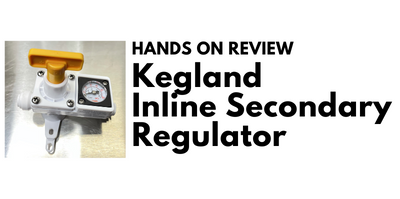





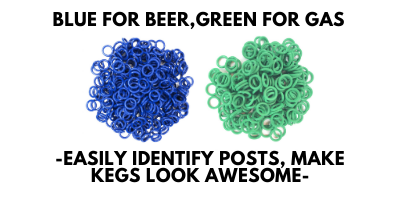







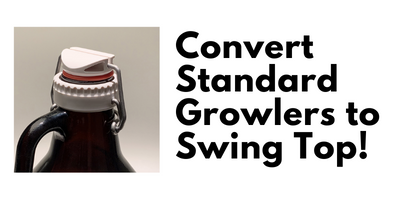






Do you have a link for the adapter to connect the regulator to the manifold? Do you allow for the 2-3 PSI drop in the manifold, due to the check valves?